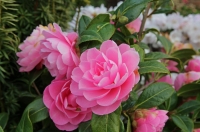
Few hardy shrubs signal the end of winter better than camellias, highly valued for their stunning floral displays and fresh, glossy, evergreen foliage. With many varieties available you’ll be spoilt for choice, so pick from camellias in shades of pink, red, white and cream.
Like azaleas and rhododendrons, camellias are ericaceous plants, and this means they need to grow in an acid or lime-free soil to ensure they stay healthy. A simple soil test kit available from garden centres can be used to check your soils acidity/alkalinity (often called its pH), and composts and fertilisers can be added to help make soil more acid.
Alternatively, compact varieties of camellia do grow well in large pots or half-barrels filled with ericaceous compost.
Grown in the right soil and position camellias usually flower reliably with little care and attention, growing larger over time to develop into impressive flowering shrubs. Most camellias rarely need pruning, but if they outgrow their position individual shoots can be shortened, and plants can even regrow well if cut back hard into old wood.
OUR POPULAR CAMELLIAS FOR POTS OR BORDERS
‘Anticipation’ – Double peony-form rose-pink flowers. Upright.
‘Donation’ Semi-double rose-pink flowers. Upright habit. Strong growing.
‘Debbie’ Peony-form pink flower. Upright. Strong growing.
‘Lavinia Maggi’ Large double white flowers with pink stripes. Medium vigour.
Jury’s Yellow’ – Anemone-form white flowers, pale yellow centre. Compact. Upright.
The very best camellias are given an Award of Garden Merit (AGM) by the Royal Horticultural Society to indicate their superb garden performance, and here are some of the most popular so look out for those with that label in store.
TOP TIPS FOR GROWING COLOURFUL CAMELLIAS
- Early flowering camellias can be damaged by frost, so position plants in a sheltered part of your garden. Move pots to sheltered sites during bad weather. Cover bushes with sheets of fleece to protect buds and blooms on frosty nights, removing it once conditions warm-up in the morning.
- Water camellias with collected rain water if possible. Some tap water contains high levels of lime (often referred to as hard water), so avoid using this to water camellias and other ericaceous plants.
- Grown in chalky soil or irrigated with hard tap water the leaves of camellias usually turn pale and yellow. Feeding these plants with an ericaceous plant food or iron sequestrene can help them regain their glossy green appearance.
- Camellias start forming flower buds during late summer and autumn, so make sure plants never go short of water through the year or poor flower development and bud drop can result.
- Make the most of the green framework of camellias to provide support for summer flowering clematis. Plant clematis in the shade at the base of camellias, and let shoots scramble up and over stems to support their summer displays.
We have plenty to choose from in-store 3 litre Pot was £19.99 save £ now £16.99 & 1.5 litre Pot was £10.99 save £1 now £9.99
